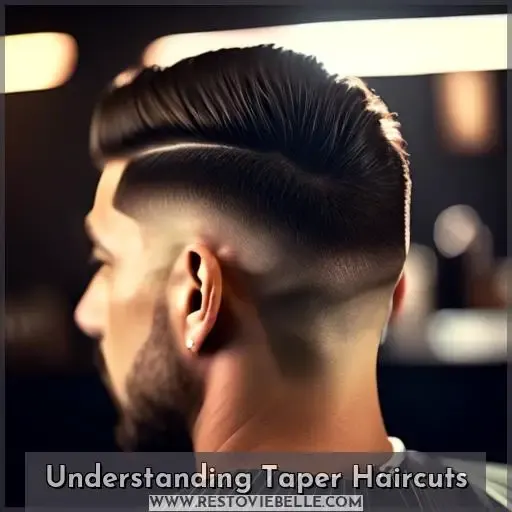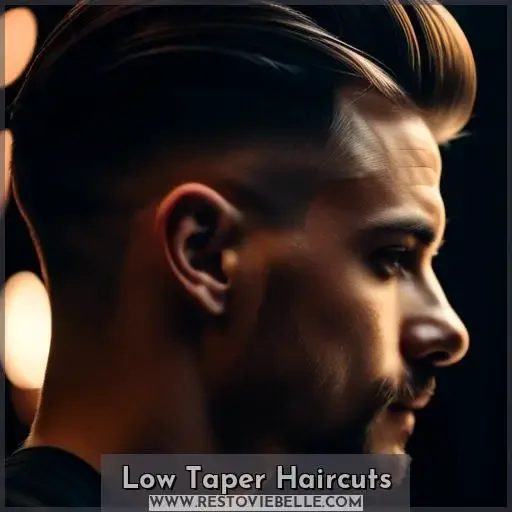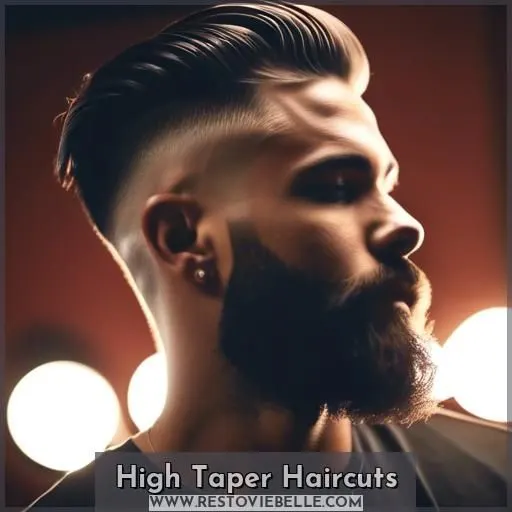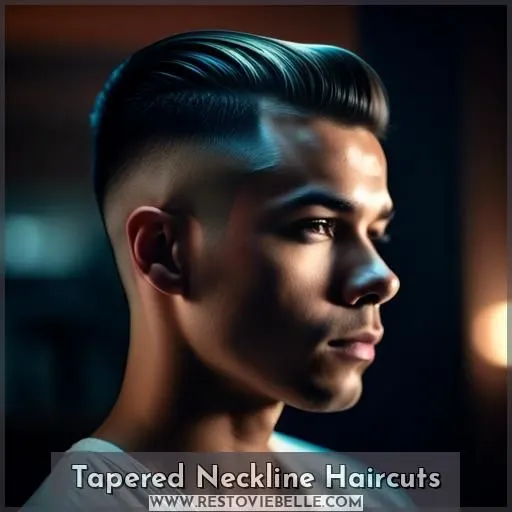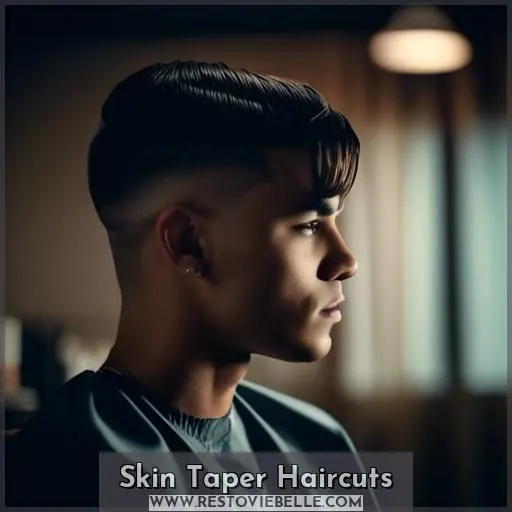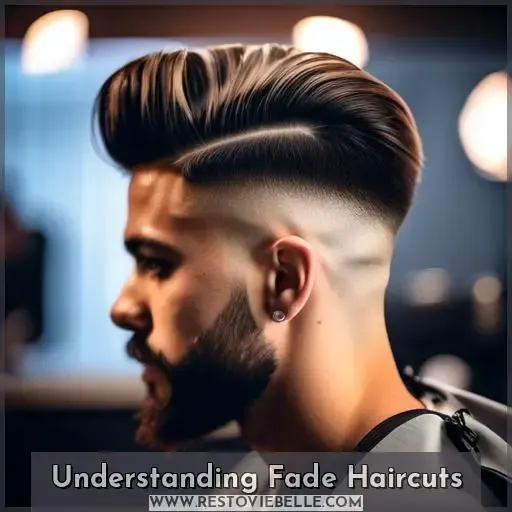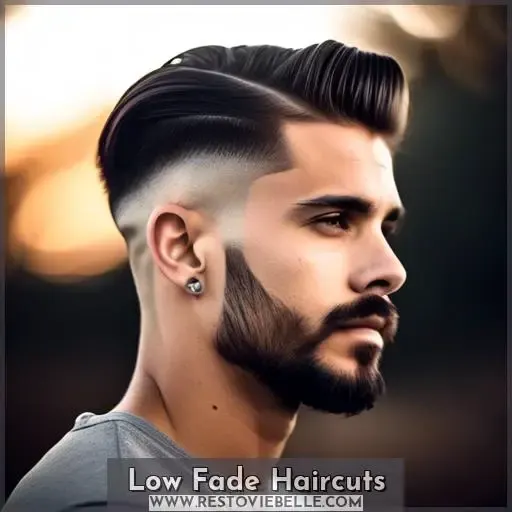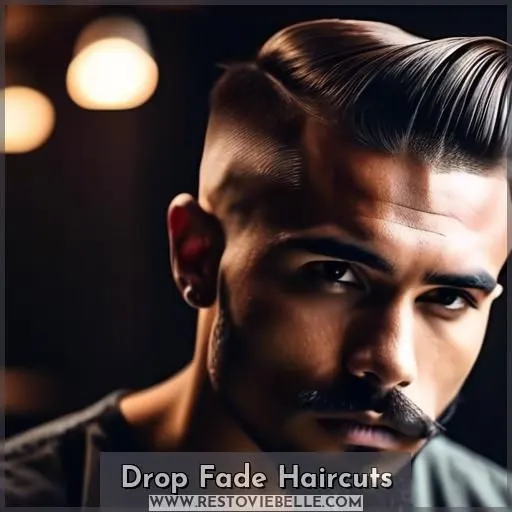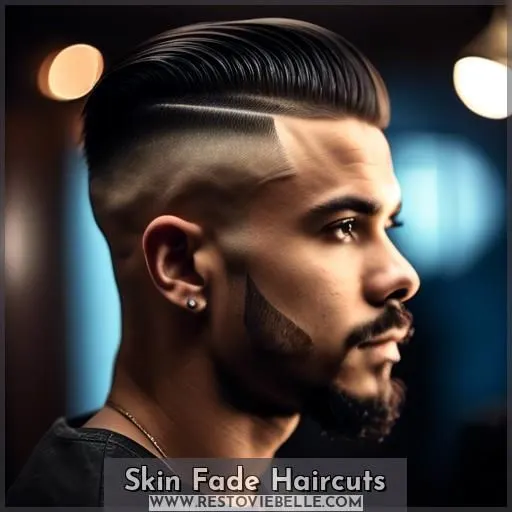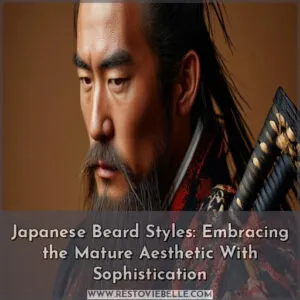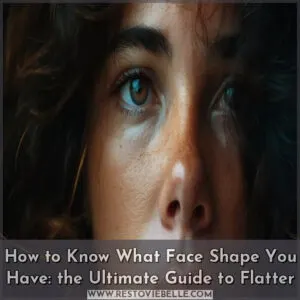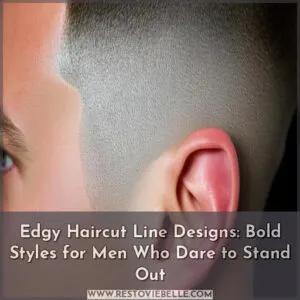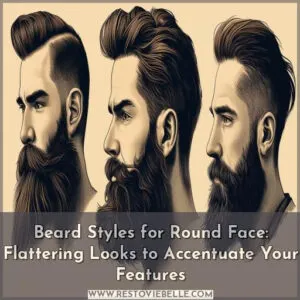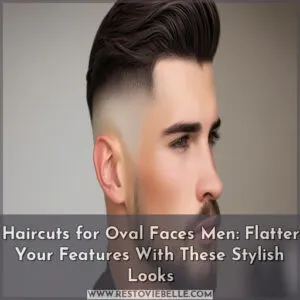This site is supported by our readers. We may earn a commission, at no cost to you, if you purchase through links.
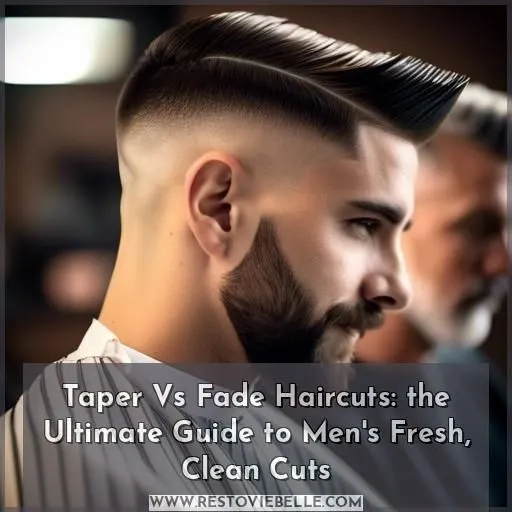 Akin to a barbershop symphony, the taper vs fade haircut debate harmonizes style and precision.
Akin to a barbershop symphony, the taper vs fade haircut debate harmonizes style and precision.
You’re a conductor seeking mastery over your mane’s movement.
Embrace the rhythm: tapers graduate smoothly while fades crescendo with contrast.
This opus guides you through nuanced artistry, empowering confident choices for a fresh, clean cut tailored to your desires.
Table Of Contents
Key Takeaways
- Taper haircuts are versatile and timeless, offering a range of styles that can be tailored to different face shapes and personal preferences.
- Taper haircuts are generally low-maintenance, requiring less frequent visits to the barber compared to fade haircuts.
- Fade haircuts involve a more dramatic contrast, often fading into the skin, while tapers are characterized by a gradual and even reduction in hair length.
- Taper haircuts can be styled in many different ways to suit your personal preferences and require regular maintenance to keep them looking sharp.
Understanding Taper Haircuts
Taper haircuts are a versatile and timeless choice for men, offering a range of styles that can be tailored to different face shapes and personal preferences. The key characteristic of a taper haircut is the gradual shortening of hair from the top to the neckline, creating a smooth and blended look.
- Taper Styles: Taper haircuts come in various styles, including low tapers, high tapers, tapered necklines, skin tapers, and undercut tapers. Each style offers a unique look and can be customized to suit different face shapes and hair types.
- Taper Maintenance: Taper haircuts are generally low maintenance, requiring less frequent visits to the barber compared to fade haircuts. The outgrowth blends naturally, making it easier to style and manage.
- Taper Shape: The shape of a taper haircut is determined by the length and style of the hair on top and the degree of taper towards the neckline. This can range from a classic, neat look to a more edgy, undercut style.
- Taper Blend: The blend of a taper haircut refers to the seamless transition between the longer hair on top and the shorter hair on the sides and back. This creates a natural and polished appearance.
- Taper vs. Fade: While both taper and fade haircuts involve shortening hair from the top to the neckline, the main difference lies in the technique and the end result. Tapers are characterized by a gradual and even reduction in hair length, while fades involve a more dramatic contrast, often fading into the skin.
In conclusion, taper haircuts offer a range of styles and are suitable for various face shapes and hair types. They’re low maintenance, easy to style, and can be customized to suit personal preferences. Understanding the key aspects of taper haircuts can help you make an informed decision when choosing a hairstyle.
Low Taper Haircuts
A low taper fade is a subtle yet clean-looking haircut that starts just above the ears and gradually shortens towards the neckline. It provides a balanced look, with the shortest hair only being about 0.25 inches long. To achieve a low taper fade, you can ask your barber for the #2 clippers to get the desired length. You can also choose to style your hair on top in different ways, such as a medium-length, semi-ragged cut that provides texture and volume.
When getting a low taper fade, it’s essential to communicate with your barber about your desired style. Bring reference photos to show them exactly what you want. You can also pick and choose elements from different reference photos, such as the texture on top, sideburns, or fade at the back. Remember, it’s your hair and your money, so you make the final call.
Maintaining a low taper fade requires regular visits to your barber for touch-ups, typically every two to three weeks. You can also maintain your haircut at home by using the right products, such as a quality hair trimmer, hair gel, and shampoo.
Low taper fades are versatile and can be styled in many different ways to suit your personal preferences. They can be paired with formal or casual outfits, making them a versatile choice for various occasions.
In summary, a low taper fade is a subtle, clean-looking haircut that starts just above the ears and gradually shortens towards the neckline. It can be styled in many different ways to suit your personal preferences and requires regular maintenance to keep it looking sharp.
High Taper Haircuts
High taper haircuts are a bold and contemporary style that adds character to your look. They involve shortening the hair several inches above the ears, creating a high contrast between the top and sides. This style is perfect for those who want to make a statement and aren’t afraid of a bit of attention.
To achieve a high taper, your barber will use a razor shave to blend the hair seamlessly. This technique requires a skilled hand, as it involves navigating the complexities of the hair’s natural growth pattern. The result is a look that’s both artistic and tailored to your face shape.
High tapers aren’t just about the hair on your head. They also include the sideburns, which are often disconnected from the rest of the hair. This adds to the overall effect, creating a look that’s both high volume and high-impact.
If you’re looking for a high taper that also includes a fade, you might want to consider a taper fade. This style seamlessly blends the high taper with a fade, creating a look that’s both sharp and natural. It’s not merely a haircut; it’s a work of art designed to enhance your features.
Tapered Neckline Haircuts
Tapered neckline haircuts are a bold and personalized way to add character to your look.
These haircuts involve a gradual shortening of hair towards the neckline, often with disconnected sideburns or designs incorporated into the tapered area.
A tapered neckline with an undercut can create a sharp contrast, while a tapered neckline with a fade offers a seamless blend of hair lengths.
These haircuts are not only designed to enhance your appearance but also require a skilled barber to execute.
In the realm of men’s grooming, tapered neckline haircuts are a testament to the ever-evolving world of haircuts, offering a bespoke and tailored approach to your personal style.
Whether you’re looking for a subtle change or a dramatic transformation, a tapered neckline haircut can help you navigate the complexities of your hair while unlocking the secrets to a fresh and clean look.
It’s not merely about the haircut; it’s about the confidence and power it brings to your everyday life.
Skin Taper Haircuts
Skin taper haircuts, also known as skin fade haircuts, are a bold and daring choice for men who want to make a statement with their hairstyle. This variation of the taper haircut involves shaving the hair close to the skin, creating a visible scalp. It’s not merely a haircut; it’s a lifestyle choice that speaks volumes about your confidence and style.
Skin taper haircuts come in various designs and lengths, each tailored to suit different facial structures and personal preferences. For instance, a skin taper with a beard can create a balanced look, while a skin taper with long hair adds a touch of sophistication. These variations are designed to enhance your features and make a lasting impression.
When it comes to skin taper haircuts, it’s important to remember that they require a skilled barber to execute properly. The process of navigating the complexities of this haircut can be daunting, but the results are worth it. In the heart of the ever-evolving world of men’s grooming, skin taper haircuts are a robust choice that underpins the everchanging trends.
If you’re seeking more than just a haircut, consider exploring the realm of skin taper haircuts. They aren’t only designed to enhance your appearance but also to unlock the secrets of your personality, revealing a bold and confident you. So, the next time you’re in the barber’s chair, don’t shy away from trying a skin taper haircut. It might just be the liberation you need.
Understanding Fade Haircuts
Fade haircuts, also known as taper fades, are a modern and bold haircut trend that offers a fresh, clean look.
- Fade and Shape: Fade haircuts are designed to create a contrast between the top and sides of your head. The fade can be low, high, or drop, and it’s all about the shape of your head and the style you want to achieve.
- Fade and Hair Type: Fade haircuts work well with various hair types. Whether you have curly, straight, or wavy hair, a fade can be customized to suit your hair type and texture.
- Fade and Products: To maintain a fade, you’ll need to use the right hair products. A good quality hair gel or pomade can help you style your fade and keep it looking sharp.
- Fade and Beard: If you have a beard, a fade can be paired with it for a seamless look. The contrast between the beard and the fade can create a balanced, stylish appearance.
- Fade Length and Contrast: The length of your fade can be adjusted to suit your preferences. A high fade, for example, starts a few inches above the ear, while a low fade starts above the ear and tapers to the neckline. The contrast between the top and the sides can be as subtle or as dramatic as you like.
Fade haircuts aren’t only a great way to make a style statement, but they also require regular maintenance to keep them looking sharp. If you’re seeking more than just a haircut, a fade could be the perfect choice for you.
Low Fade Haircuts
Low fade haircuts have been making waves in the world of men’s grooming for their subtle yet stylish transition from longer hair on top to shorter hair on the sides and back. These cuts offer a clean, polished look without being too extreme, making them a popular choice for a variety of face shapes and personal styles. Let’s dive into the low fade haircut, discussing its types, styles, trends, maintenance, and face shapes.
Types of Low Fade Haircuts
- Curvy Line Low Fade: This cut features a shaved line that adds sharp edges, lines, and curves to the haircut, giving it a unique and eye-catching appearance.
- Low Fade Taper Cut with Spikes: This style combines the neatness of a low fade with the edginess of spiky hair on top, creating a balanced look.
- Short Low Fade Hairstyle: Ideal for guys with thick or medium-textured hair, this cut keeps the hair neat and sharp around the front while allowing for a short length on the sides and back.
- Low Fade Volume Maker: This cut provides volume on top without requiring too much time for styling after washing.
- Low Bald Fade: A low bald fade involves slicking the hair back on top and adding a bit of stubble for contrast.
- Low Fade Pompadour: This classic style adds a modern twist with a low fade, creating a stylish and timeless look.
Styles and Trends
Low fade haircuts are versatile and can be tailored to suit different face shapes and personal preferences. Some popular styles include the two-block haircut, which imparts a youthful charm with a low fade; the low neck fade, which blends the hair from a slightly longer length at the top of the neck to a shorter length towards the back; and the burst fade, which features a circular pattern of hair tapering around the ears and back of the head.
Maintenance and Face Shapes
Maintaining a low fade haircut is relatively simple, requiring regular visits to a hairstylist for touch-ups every two to four weeks to keep the fade looking clean and sharp. The low fade is best suited for oval, rectangular, and diamond-shaped faces, as it complements these face shapes by adding texture and depth without accentuating the roundness of the face.
In conclusion, low fade haircuts offer a subtle yet stylish transition from longer hair on top to shorter hair on the sides and back. With a variety of styles and trends to choose from, these cuts can be tailored to suit different face shapes and personal preferences. Regular maintenance is key to keeping the fade looking clean and sharp, making low fade haircuts a great choice for men seeking a fresh and clean look.
Drop Fade Haircuts
If you’re looking for a bold and versatile haircut, a drop fade might be the perfect choice for you. This haircut follows the shape of your head, dropping below the ears, creating a unique and striking look. Drop fades aren’t just about the hair on your head; they also offer a range of options for your facial hair.
Drop Fade Styling
When it comes to styling your drop fade, there are a few things to consider. First, the hair length can vary depending on your preference. Some men prefer a shorter drop fade, while others might opt for a longer one. The key is to find a length that suits your face shape and personal style.
Drop Fade Beard
Pairing your drop fade with a beard is another option. A drop fade beard can add texture and depth to your look, while also providing a clean and well-groomed appearance. It’s essential to maintain your beard regularly to ensure it complements your drop fade haircut.
Drop Fade Hair Types
Drop fades work well with various hair types. Whether you have thick, curly, or straight hair, a drop fade can be tailored to suit your hair’s natural texture. It’s essential to communicate with your barber to ensure they understand your hair type and can create a drop fade that complements your features.
Drop Fade Maintenance
Maintaining your drop fade requires regular trims to keep the hairline sharp and the fade even. It’s advisable to visit your barber every 2-4 weeks, depending on your hair’s growth rate. This may seem daunting, but the results are well worth the effort.
In conclusion, a drop fade haircut is a bold and versatile choice for men seeking a fresh and clean look. With various styling options, it’s not merely a haircut; it’s a statement.
Skin Fade Haircuts
Skin fades, also known as bald fades, are a popular choice for men seeking a clean, sharp look.
This haircut involves shaving the hair close to the skin, creating a visible scalp.
The fade can be low, starting just above the ears, or drop, following the shape of the head and dropping below the ears.
Skin fades are a bold move that requires a skilled barber to execute.
They aren’t for everyone, as they reveal the face shape and hair type.
However, they can be tailored to suit personal style and face shape.
For those with a strong jawline, a skin fade can add texture and depth.
For those with a round face, it can balance volume.
Skin fades are a great option for those who want to make a statement with their haircut.
They require regular maintenance to maintain their sharpness, but the results are worth it.
Frequently Asked Questions (FAQs)
How do I style a taper haircut?
Style a taper haircut with a matte pomade or wax for textured hold. Work the product through dry hair, using your fingers to mold strands into your desired messy or refined look – the taper cut creates a versatile canvas.
Can fades work with all hair textures?
Around 65% of men sport fade haircuts these days. You can absolutely rock a fade with any hair type – from straight to curly.
What face shapes suit taper haircuts best?
You’ll look sharp with a taper cut if you have an oval, square, or diamond-shaped face. The gradual length creates balance, highlighting your killer jawline and face symmetry.
Are fade haircuts suitable for professional environments?
Fades can absolutely be professional – rock a low or medium fade with some length on top. Tapered sides keep it clean-cut while longer hair on top allows versatility. Just avoid super high or disconnected fades for a more corporate-friendly look.
How often should I wash a fade haircut?
Fastidiously fresh fades flawlessly frame fabulous faces. You’ll want to wash your fashionable fade frequently, every 2-3 days ideally, to keep that crisp contrast cravingly clean.
Conclusion
Mastering the taper vs fade haircut symphony requires finesse, but you’re now equipped with the notes to orchestrate your mane movement. Whether graduating smoothly or crescendoing with contrast, the fresh, clean cut you crave awaits, tailored to your unique style.
